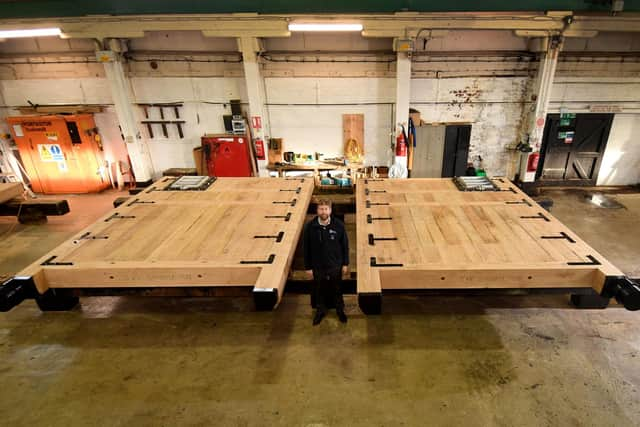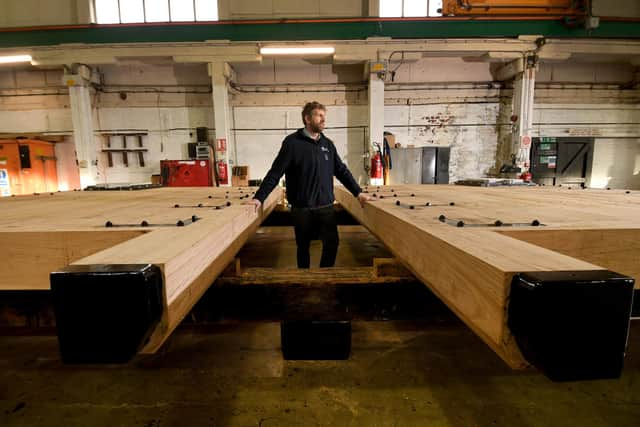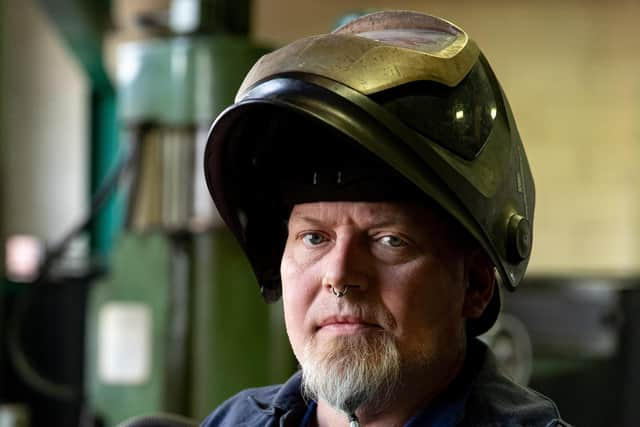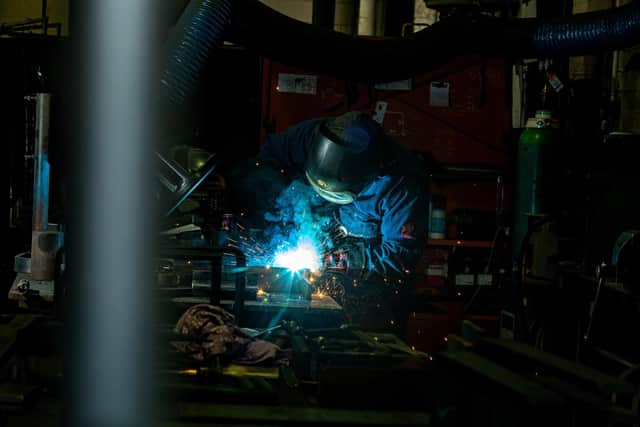Take a look behind the scenes of the Yorkshire workshop helping to keep our canals afloat
Stanley Ferry is one of only two places in the UK (the other is in Bilston in the West Midlands) where lock gates are manufactured and refurbished by the Canal & River Trust, the charity responsible for 2,000 miles of waterways in England and Wales.
Inside the workshop the winter programme – part of the trust’s £58m repair and restoration work – is well under way. The skilled teams of joiners and fabricators are busy handcrafting new lock gates that will be installed across 52 locks around the country. Among those being worked on at the moment are gates for the Ripon Canal and the Grand Union Canal, which stretches from London to Birmingham.
Advertisement
Hide AdAdvertisement
Hide AdThe average lifespan of a lock gate is around 25 years which, given the vast canal network, means that there is no shortage of work. Each lock on Britain’s canal network is a different size so all the gates have to be painstakingly made to measure.


“We’re busy all the way through the year because some of these gates will take three or four weeks to make, so our programme is ongoing,” says Andrew Bayliss, the workshop supervisor. “I’ve been here 24 years now and we’ve never stopped.”
One of the reasons for this is that back in the 1980s and ‘90s a lot of restoration work was carried out which now needs updating. “We go from Kennet & Avon up to Ripon and even as far up as the Tees Valley,” says Andrew. “It’s all interesting whatever you’re working on. We’d have a really boring canal if every gate looked the same.”
The Stanley Ferry Workshop has eight joiners on the factory floor who operate in teams of two, a couple of fabricators and a machinist who planes the wood to size.
Advertisement
Hide AdAdvertisement
Hide Ad“The basic principles behind making the gates are very simple, it’s mortise and tenon joints and things like that, but you couldn’t bring someone straight in from outside and expect them to make a lock gate. It takes between two and three years to get the understanding of how it all goes together, and you have to remember that each canal network is different,” adds Andrew.


He started out as a joiner and worked his way up. “Most people stay here for quite a long time because it’s so unique what we do,” he says.
The workshop also has two apprentices, including Korey Wigglesworth a welder and fabricator from nearby Knottingley. The 19 year-old, who started in September, heard about the job at Castleford College where he is studying.
“I make hoops for the gates and the safety brackets to stop them from cracking,” he says.
Advertisement
Hide AdAdvertisement
Hide Ad“I’ve never done owt like it before and the machines you won’t find anywhere else except here which is good because it means I’m learning all the time.”


At the end of his two-year apprenticeship, Korey will be a fully qualified welder and fabricator.
“I’m working with a bloke called Tommy who’s been here nearly 40 years and the whole point of me coming in is when he retires he’ll have passed his knowledge to me and then I can carry it on.”
Luke Wrzosek is a carpenter who has been working here for the past nine years, having started out as an apprentice. “We do other work from time to time but it’s mostly doing lock gates,” he says. “To the average person, the work probably looks a bit repetitive but because every single lock gate is different, it means every day is different.”
Advertisement
Hide AdAdvertisement
Hide AdThe workshop itself predates the Second World War, though the manufacturing of lock gates became a focal point after 1945, as Andrew explains.


“During the war they stored sandbags here because this place was originally built for manufacturing ‘Tom Puddings’ [the name given to tub boats on the Aire & Calder Navigation] for the canal network to go to the power stations.”
Britain’s canals are a feat of engineering ingenuity that is envied the world over and without them there would have been no Industrial Revolution. Their role, though, has changed over time. In the past, they were vital arteries connecting towns, cities and ports helping to power Britain’s industries. But as heavy industry declined, so did these waterways.
This reached a nadir in the 1970s and ’80s, by which time many had become polluted eyesores and relics of a bygone age.
Advertisement
Hide AdAdvertisement
Hide AdIn recent decades, though, thanks to the Canal & River Trust and the tireless work of campaigners and canal enthusiasts, they have been given a new lease of life.
It’s estimated that around 1.1 million people in this country live within one kilometre of a waterway and during the Covid pandemic many reconnected with their local canals or explored them properly for the first time, something that the waterways and wellbeing charity is keen to encourage.
“I think the canals were vital during the Covid lockdowns,” says Andrew. “The footfall we had during this time was incredible and it’s kept going. Sometimes you don’t realise how close you are to a green space and just having that bit of fresh air can really boost your mental health.”
The charity relies on funding from government grants and donations, as well as commercial income such as boating licence fees, and Richard Parry, chief executive at Canal & River Trust, says it’s crucial this continues.
Advertisement
Hide AdAdvertisement
Hide Ad“Climate change – both heavy rain and drought – presents significant and costly challenges to assets which were built when industrial civil engineering was first being developed. It’s more important than ever that these historic waterways are properly funded so we can preserve them for boaters, neighbours, and all those who spend time by them,” he says.
It’s something Andrew agrees with. “I don’t think canals get the recognition they should. We’ve got the Anderton Boat Lift and the Pontcysyllte Aqueduct and places like that all over the country. For me, they’ve got the same status as the Taj Mahal in terms of heritage.
“For future generations we don’t want all this to disappear. We want to explain this heritage to our children and grandchildren and what we do at our workshops is part of that. If we didn’t make the gates, the canals would just disappear.”
The workshop is normally closed to the public, but as part of its engagement work and to help drum up support and encourage people to get involved in a variety of volunteering roles, it holds open days allowing visitors to see what goes on behind the scenes.
Advertisement
Hide AdAdvertisement
Hide Ad“People love it when they come down,” says Andrew. “You get the public, boaters and engineers having a look around, and children coming down – everybody seems interested in what we do. We had an open day not long ago and we got over a hundred people.”
There’s a sense of pride, too, among those in the workshop. “When you think it’s over 200-odd years since the canals were built, you just have to marvel at what they did and how they did it. And now we’re making something that’s going to help to keep that heritage going.”
For more information and to find out about volunteering and the Winter Open Days visit canalrivertrust.org.uk